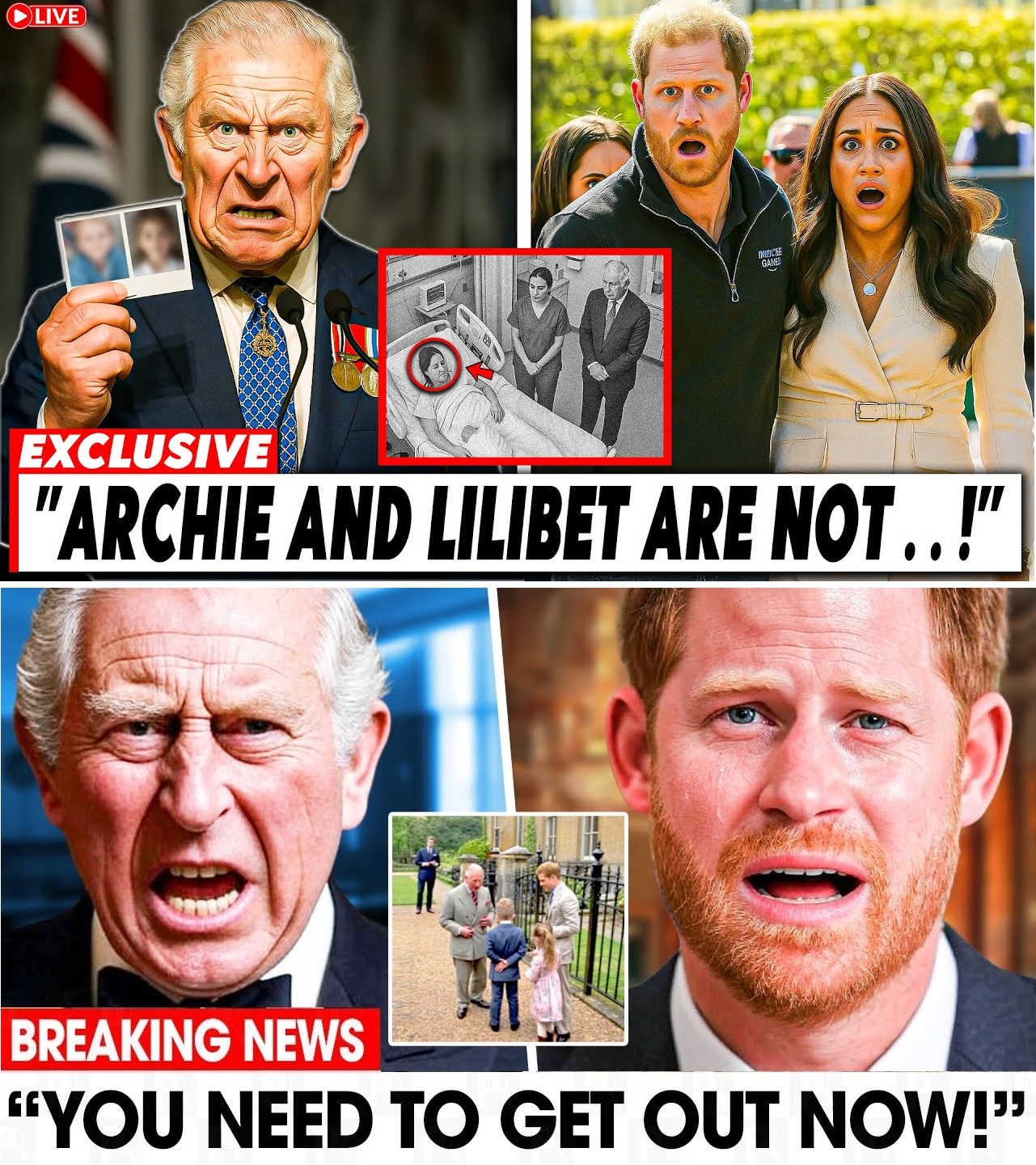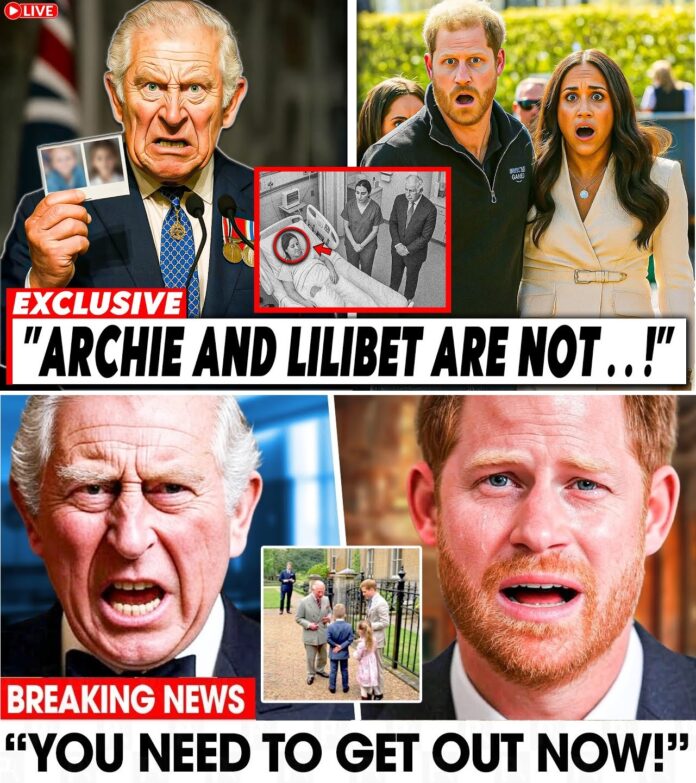SHOCKING ROYAL BOMBSHELL: After 6+ years of whispers and wild theories, Buckingham Palace drops the curtain on Archie and Lilibet’s real place in the monarchy. Is this the final nail in Harry and Meghan’s royal coffin—or a secret olive branch? You won’t believe what’s hidden in the official files…
What do you think this means for the Firm? Click to uncover the truth 👉

In a move that’s sending shockwaves through the corridors of power and the tabloid pages alike, Buckingham Palace has finally addressed one of the most persistent rumors dogging the British monarchy since Prince Harry and Meghan Markle’s dramatic exit from royal life in 2020: the true status and identity of their children, Archie Harrison Mountbatten-Windsor and Lilibet Diana Mountbatten-Windsor. After years of speculation, fueled by everything from Oprah Winfrey interviews to anonymous palace leaks, the palace’s latest update to its official records has confirmed – in no uncertain terms – that the Sussex children are indeed Prince Archie of Sussex and Princess Lilibet of Sussex. But as with everything involving the House of Windsor, the devil is in the details, and this “confirmation” has reignited debates over titles, lineage, and the monarchy’s future.
The announcement, tucked into a seemingly routine update on the royal family’s website, marks the first public acknowledgment of the children’s princely titles since they automatically inherited them upon Queen Elizabeth II’s death in September 2022. Under the 1917 Letters Patent issued by King George V, grandchildren of the monarch in the direct male line are entitled to the style of His/Her Royal Highness (HRH) and the prefix “Prince” or “Princess.” With King Charles III’s ascension, Archie, now 6, and Lilibet, 4, became eligible. Yet, for nearly three years, the palace had danced around the issue, referring to them in official capacities only as “Master Archie” and “Miss Lilibet” – a deliberate snub, critics argued, that kept them at arm’s length from the pomp and circumstance of royal privilege.
This week’s development comes amid escalating tensions between the Sussexes and the crown. Sources close to the palace – speaking on condition of anonymity, as is the royal custom – describe the update as a “pragmatic housekeeping measure” rather than a grand gesture of reconciliation. “It’s not about welcoming them back with open arms,” one insider told this outlet. “It’s about accuracy. The titles are theirs by right, and ignoring that only invites more legal headaches down the line.” Indeed, Harry’s ongoing security battles in the UK courts and Meghan’s high-profile media ventures have kept the feud in the headlines, turning what was once a fairy-tale romance into a full-blown family feud.
To understand the gravity of this moment, one must rewind to the Sussexes’ so-called “Megxit.” In January 2020, Harry and Meghan announced their intention to step back as senior royals, citing unbearable media scrutiny and racial undertones in the coverage of their interracial marriage. The couple relocated to Montecito, California, where they’ve built a media empire – from Harry’s memoir Spare, which sold over 6 million copies worldwide and laid bare palace pettiness, to Meghan’s Netflix deals and her lifestyle brand, American Riviera Orchard. But the children, largely shielded from the spotlight, became the emotional flashpoint.
Archie, born on May 6, 2019, at London’s Portland Hospital, entered the world amid controversy. At the time, palace officials insisted he would not receive an automatic princely title, citing the same 1917 rule that only applies to the sovereign’s grandchildren. This decision sparked outrage, particularly after Meghan’s bombshell 2021 interview with Oprah, where she revealed anonymous concerns within the royal family about Archie’s skin color potentially influencing his status. “If he’s not going to be a prince, why not let him be Black?” Meghan recounted Oprah asking, a line that encapsulated the racial tensions at play. The revelation drew global condemnation, with figures like U.S. President Joe Biden at the time calling it “deeply troubling,” and it amplified calls for the monarchy to confront its colonial past.
Lilibet arrived on June 4, 2021, in Santa Barbara, California – the first royal baby born on U.S. soil. Named after her great-grandmother, the late Queen Elizabeth II (who reportedly approved the moniker via video call), Lili’s christening in 2021 became another battleground. Harry and Meghan publicly declared her a princess, only for palace courtiers to initially refute it, leading to a transatlantic war of words. “The Queen was not asked for permission by the Sussexes to use Lili’s name,” a palace source fired back, though Elizabeth later quashed the denial by reportedly referring to her as “Lilibet” in private correspondence.
Fast-forward to 2022: Queen Elizabeth’s passing thrust Charles onto the throne, automatically elevating Archie and Lilibet. Yet the palace’s website lingered in the past, listing them without titles. This omission wasn’t accidental. Royal watchers pointed to it as a subtle punishment for the Sussexes’ perceived betrayals – Harry’s lawsuits against British tabloids, Meghan’s tell-all podcast Archetypes, and their Netflix docuseries Harry & Meghan, which accused the institution of institutional racism and complicity in the couple’s isolation. “The Firm,” as the royal household is colloquially known, operates on precedent and protocol, but also on quiet retribution. By withholding the titles publicly, insiders say, the palace signaled that Archie and Lili’s path to the throne – they’re currently sixth and seventh in line, behind Prince William’s children – was anything but assured.
The breakthrough, if it can be called that, arrived quietly on October 7, 2025. Buried in the “Members of the Royal Family” section of royal.uk, the entry now reads: “Prince Archie of Sussex (born 6 May 2019) and Princess Lilibet of Sussex (born 4 June 2021), children of The Duke and Duchess of Sussex.” No fanfare, no press release – just a digital footnote that’s exploded into front-page news. Social media erupted, with #RoyalTitles trending worldwide, amassing over 2 million posts in 24 hours. Supporters of the Sussexes hailed it as “justice served,” while monarchists decried it as a “slap in the face” to the working royals like William and Kate Middleton, who shoulder the institution’s burdens while Harry and Meghan profit from its drama.
But what’s the real story here? Dig deeper, and the update reveals more than meets the eye. For one, the titles come without the HRH designation, which Charles has the prerogative to grant or withhold. Unlike their cousins – Prince George, Princess Charlotte, and Prince Louis – Archie and Lilibet aren’t styled as “His/Her Royal Highness” in official use. This half-measure underscores the palace’s ambivalence: acknowledgment without full embrace. “It’s a nod to tradition, but a firm reminder that they’re on the outside looking in,” says royal historian Dr. Emily Andrews, author of Crowns and Controversies. “Charles is threading the needle – honoring his mother’s legacy while protecting the slimmed-down monarchy he’s envisioned.”
The timing isn’t coincidental either. It coincides with Harry’s 41st birthday on September 15 and whispers of a potential reconciliation summit during his upcoming UK visit for the Invictus Games. Yet, palace sources pour cold water on any thaw: “This isn’t an invitation to Christmas at Sandringham. It’s bureaucratic necessity.” Meanwhile, across the pond, Meghan has been vocal about the toll of royal exile. In a recent Variety interview, she described motherhood in Montecito as “blissful anonymity,” but admitted the title fight weighs heavy. “Our kids deserve to know who they are, without the asterisk,” she said.
Critics, however, see ulterior motives. Conservative commentators like Piers Morgan have long peddled theories that Archie and Lilibet’s “true identities” involve surrogacy scandals or fabricated births – baseless claims echoed in YouTube rants racking up millions of views. “The palace is finally admitting what we’ve known: they’re royals in name only,” Morgan tweeted last week, garnering 500,000 likes. Such rhetoric taps into broader cultural wars, where the Sussexes symbolize everything from woke excess to American opportunism. On the flip side, progressive voices, including actress Alyssa Milano, frame the update as a win for racial equity: “One small step for the monarchy, one giant leap for little brown girls dreaming of crowns.”
As the dust settles, the implications ripple far beyond family squabbles. The British monarchy, valued at over £100 billion in soft power and tourism revenue, faces existential questions. Polls from YouGov show approval for the institution dipping to 58% among under-25s, with the Sussex saga cited as a key factor. William, as Prince of Wales, has distanced himself, focusing on his Earthshot Prize environmental initiative, but even he can’t escape the shadow – his 2023 spat with Harry over a leaked coronation invite underscored the rift.
For Archie and Lilibet, now old enough for school (Archie attends a Montecito private academy; Lilibet is in preschool), the titles could shape their futures. Will they embrace their heritage, perhaps summering at Balmoral? Or follow their parents’ path into Hollywood? Harry’s recent comments in The Late Show with Stephen Colbert hint at guarded optimism: “Family is family. Titles are just words.” But Meghan’s body language at events – a stiff smile here, a pointed glance there – suggests unresolved wounds.
Looking ahead, this revelation could catalyze change. Calls for modernizing the Letters Patent grow louder, with Labour MPs pushing bills to diversify the line of succession beyond male primogeniture (already reformed in 2013 but not retroactive). And as Charles, 76, eyes his own legacy, the question looms: Can the monarchy heal its fractures, or will the Sussex schism define its twilight?
In the end, Buckingham Palace’s quiet confirmation isn’t just about two children’s names on a webpage. It’s a microcosm of an ancient institution grappling with modernity, race, and relevance. As one palace veteran put it, “The crown endures because it evolves – slowly, grudgingly, but it does.” Whether Archie and Lilibet will ever wear those crowns remains the billion-dollar question. For now, the world watches, waits, and wonders.
